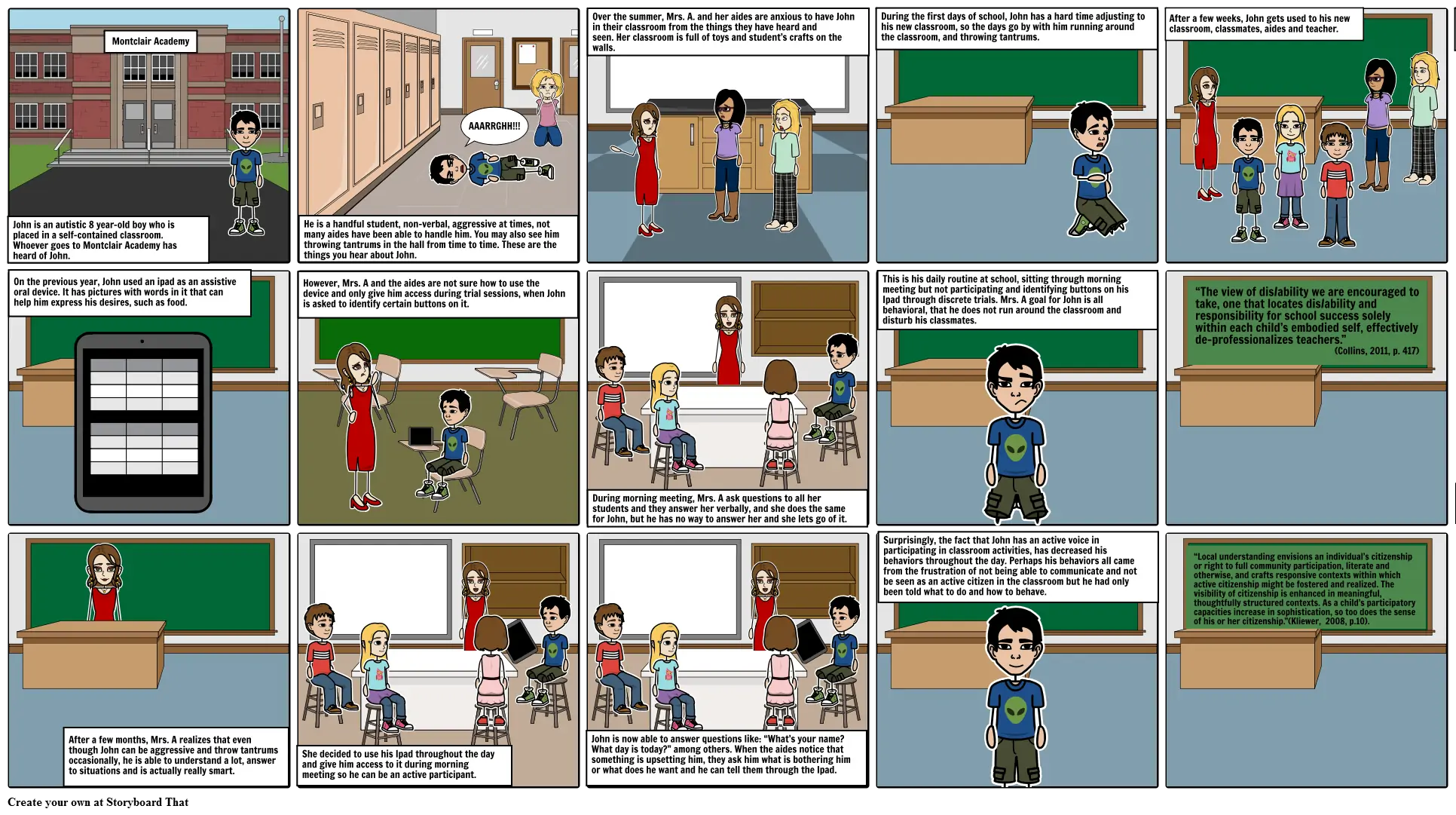Behind what we see

Storyboard Text
- John is an autistic 8 year-old boy who is placed in a self-contained classroom. Whoever goes to Montclair Academy has heard of John.
- Montclair Academy
- He is a handful student, non-verbal, aggressive at times, not many aides have been able to handle him. You may also see him throwing tantrums in the hall from time to time. These are the things you hear about John.
- AAARRGHH!!!
- Over the summer, Mrs. A. and her aides are anxious to have John in their classroom from the things they have heard and seen. Her classroom is full of toys and student’s crafts on the walls.
- During the first days of school, John has a hard time adjusting to his new classroom, so the days go by with him running around the classroom, and throwing tantrums.
- After a few weeks, John gets used to his new classroom, classmates, aides and teacher.
- On the previous year, John used an ipad as an assistive oral device. It has pictures with words in it that can help him express his desires, such as food.
- On the previous year, John used an ipad as an assistive oral device. It has pictures with words in it that can help him express his desires, such as food.
- However, Mrs. A and the aides are not sure how to use the device and only give him access during trial sessions, when John is asked to identify certain buttons on it.
- During morning meeting, Mrs. A ask questions to all her students and they answer her verbally, and she does the same for John, but he has no way to answer her and she lets go of it.
- This is his daily routine at school, sitting through morning meeting but not participating and identifying buttons on his Ipad through discrete trials. Mrs. A goal for John is all behavioral, that he does not run around the classroom and disturb his classmates.
- “The view of dis/ability we are encouraged to take, one that locates dis/ability and responsibility for school success solely within each child’s embodied self, effectively de-professionalizes teachers.” (Collins, 2011, p. 417)
- She decided to use his Ipad throughout the day and give him access to it during morning meeting so he can be an active participant.
- After a few months, Mrs. A realizes that even though John can be aggressive and throw tantrums occasionally, he is able to understand a lot, answer to situations and is actually really smart.
- She decided to use his Ipad throughout the day and give him access to it during morning meeting so he can be an active participant.
- John is now able to answer questions like: “What’s your name? What day is today?” among others. When the aides notice that something is upsetting him, they ask him what is bothering him or what does he want and he can tell them through the Ipad.
- Surprisingly, the fact that John has an active voice in participating in classroom activities, has decreased his behaviors throughout the day. Perhaps his behaviors all came from the frustration of not being able to communicate and not be seen as an active citizen in the classroom but he had only been told what to do and how to behave.
- “Local understanding envisions an individual’s citizenship or right to full community participation, literate and otherwise, and crafts responsive contexts within which active citizenship might be fostered and realized. The visibility of citizenship is enhanced in meaningful, thoughtfully structured contexts. As a child’s participatory capacities increase in sophistication, so too does the sense of his or her citizenship.”(Kliewer, 2008, p.10).
Over 30 Million Storyboards Created
No Downloads, No Credit Card, and No Login Needed to Try!
